Species
A species is a group of organisms that are capable of interbreeding and producing fertile offspring. Organisms within the same species are similar in appearance, behavior, and genetic makeup.
Characteristics of Species
- Morphological Similarity: Members of the same species have similar physical characteristics.
- Genetic Similarity: They share a high degree of genetic similarity due to their ability to interbreed.
- Behavioral Similarity: Members of the same species often exhibit similar behaviors and communication patterns.
- Fertile Offspring: When members of the same species reproduce, they produce fertile offspring.
Classification of Species
Species are classified based on their evolutionary relationships and genetic similarities. The system of classification used to categorize species is called taxonomy.
Importance of Species
Species are fundamental units of biodiversity and play a crucial role in ecosystems. They contribute to ecological balance, provide ecosystem services, and have intrinsic value. Understanding species is essential for conservation efforts and maintaining the health of the planet.
Study Guide
- Define the term "species" and explain its significance in biology.
- Discuss the criteria used to define and classify species.
- Explain the concept of reproductive isolation and its role in defining species boundaries.
- Describe the importance of species in maintaining ecological balance and biodiversity.
- Discuss the impact of human activities on species extinction and conservation efforts.
[Species] Related Worksheets and Study Guides:
.◂Science Worksheets and Study Guides Sixth Grade. Mollusks, Arthropods and Echinoderms
Study Guide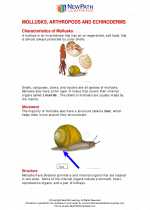 Mollusks, Arthropods and Echinoderms
Mollusks, Arthropods and Echinoderms  Activity Lesson
Activity Lesson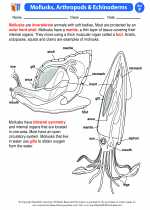 Mollusks, Arthropods & Echinoderms
Mollusks, Arthropods & Echinoderms  Worksheet/Answer key
Worksheet/Answer key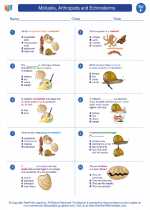 Mollusks, Arthropods and Echinoderms
Mollusks, Arthropods and Echinoderms  Worksheet/Answer key
Worksheet/Answer key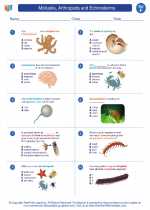 Mollusks, Arthropods and Echinoderms
Mollusks, Arthropods and Echinoderms  Worksheet/Answer key
Worksheet/Answer key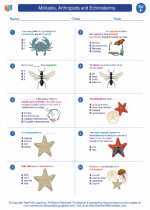 Mollusks, Arthropods and Echinoderms
Mollusks, Arthropods and Echinoderms  Worksheet/Answer key
Worksheet/Answer key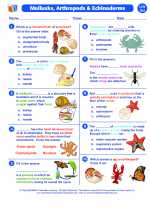 Mollusks, Arthropods and Echinoderms
Mollusks, Arthropods and Echinoderms  Vocabulary/Answer key
Vocabulary/Answer key Mollusks, Arthropods and Echinoderms
Mollusks, Arthropods and Echinoderms  Vocabulary/Answer key
Vocabulary/Answer key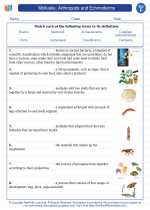 Mollusks, Arthropods and Echinoderms
Mollusks, Arthropods and Echinoderms  Vocabulary/Answer key
Vocabulary/Answer key Mollusks, Arthropods and Echinoderms
Mollusks, Arthropods and Echinoderms  Vocabulary/Answer key
Vocabulary/Answer key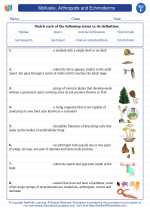 Mollusks, Arthropods and Echinoderms
Mollusks, Arthropods and Echinoderms  Vocabulary/Answer key
Vocabulary/Answer key Mollusks, Arthropods and Echinoderms
Mollusks, Arthropods and Echinoderms  Vocabulary/Answer key
Vocabulary/Answer key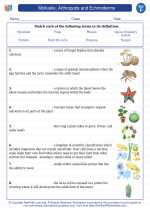 Mollusks, Arthropods and Echinoderms
Mollusks, Arthropods and Echinoderms  Vocabulary/Answer key
Vocabulary/Answer key Mollusks, Arthropods and Echinoderms
Mollusks, Arthropods and Echinoderms 

 Activity Lesson
Activity Lesson
 Worksheet/Answer key
Worksheet/Answer key
 Worksheet/Answer key
Worksheet/Answer key
 Worksheet/Answer key
Worksheet/Answer key
 Worksheet/Answer key
Worksheet/Answer key
 Vocabulary/Answer key
Vocabulary/Answer key
 Vocabulary/Answer key
Vocabulary/Answer key
 Vocabulary/Answer key
Vocabulary/Answer key
 Vocabulary/Answer key
Vocabulary/Answer key
 Vocabulary/Answer key
Vocabulary/Answer key
 Vocabulary/Answer key
Vocabulary/Answer key
 Vocabulary/Answer key
Vocabulary/Answer key

The resources above cover the following skills:
LIFE SCIENCE
From Molecules to Organisms: Structures and Processes